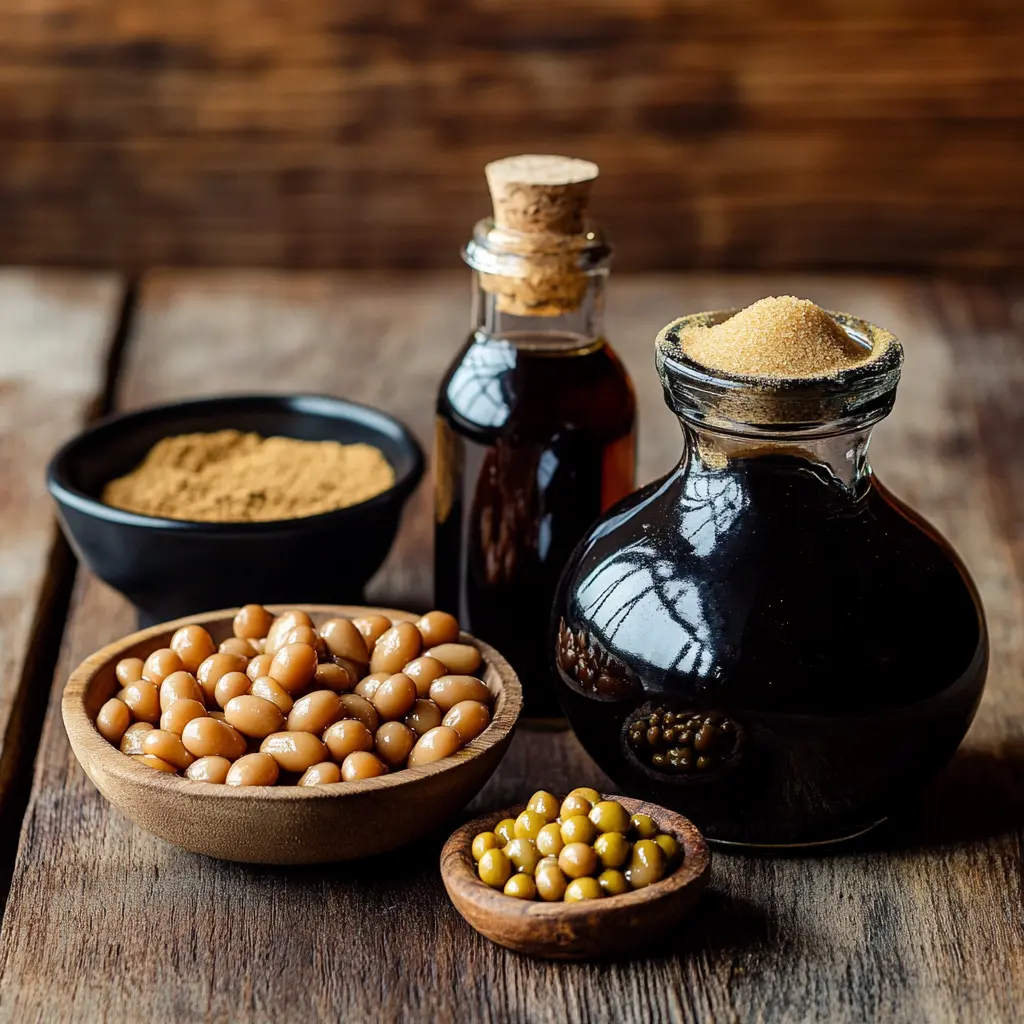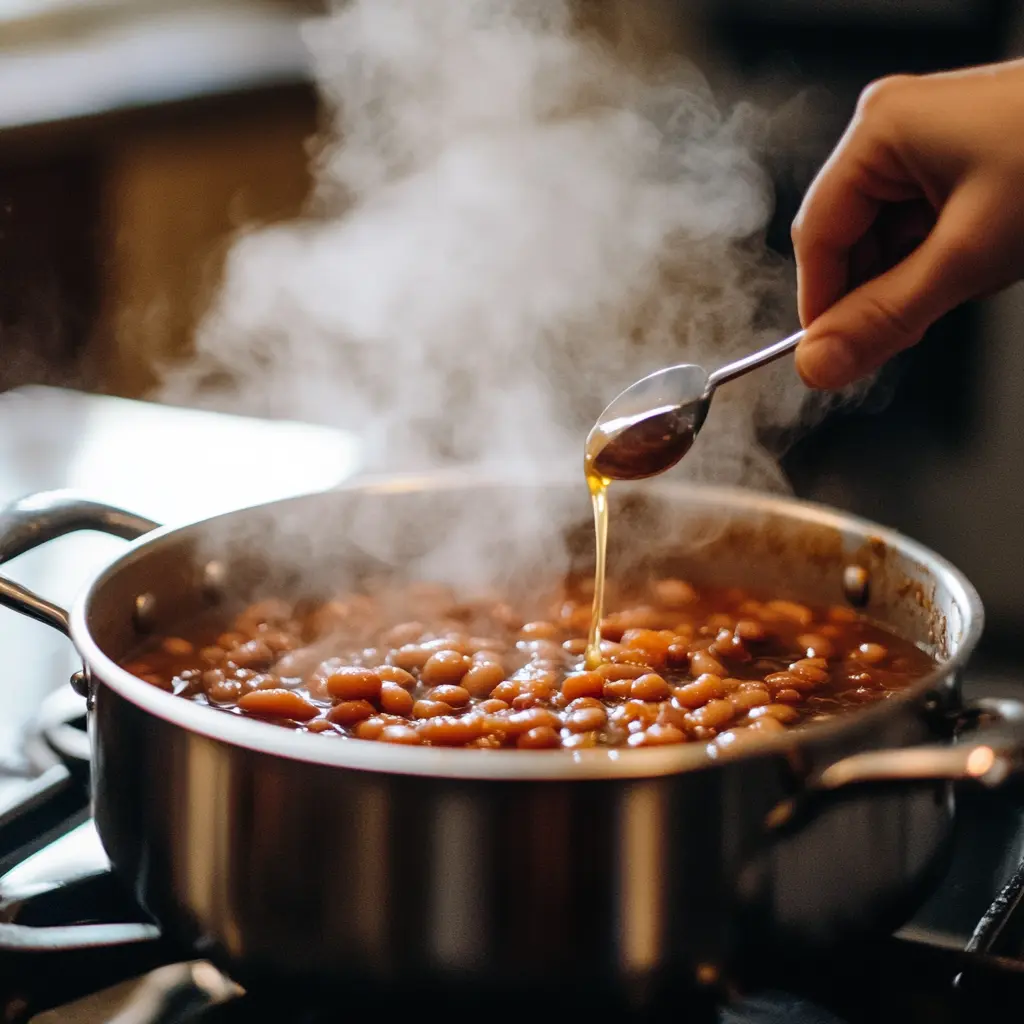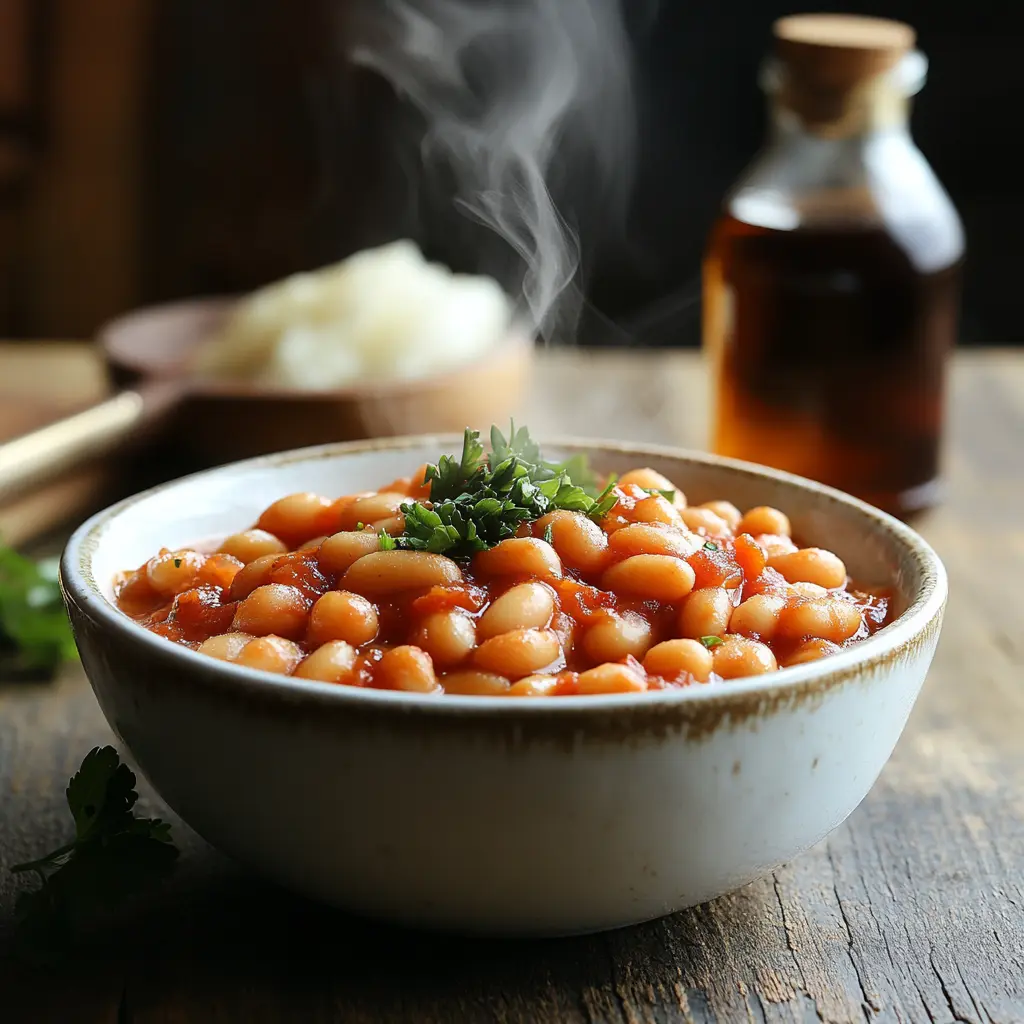Part 1: Introduction
Why Vinegar Holds a Special Place in Cooking
Vinegar has been a staple in kitchens worldwide for centuries. This versatile ingredient, made by fermenting ethanol into acetic acid, boasts multiple culinary uses, from enhancing flavors to acting as a natural preservative. Its acidic properties are the secret sauce behind its incredible ability to balance and intensify flavors in dishes, including baked beans.
But why baked beans specifically? Well, the beans’ hearty texture and natural sweetness make them an ideal canvas for vinegar’s magic. The slight tang helps cut through the richness while complementing the sweetness of molasses, sugar, or honey often used in baked bean recipes.
Enhancing Flavors with Acidity
Acidity is crucial in cooking because it brightens and balances the flavors in a dish. In baked beans, the acidic tang of vinegar accentuates the smoky, sweet, and savory elements, creating a well-rounded taste. It’s like the final brushstroke on a painting — subtle yet transformative.

Vinegar as a Natural Preservative
Beyond its flavor-enhancing properties, vinegar serves as a natural preservative. Its acidic nature inhibits the growth of bacteria, which can be a game-changer for homemade baked beans. Adding vinegar not only prolongs the dish’s shelf life but also ensures it remains fresh and safe to eat.
Historical Roots of Vinegar in Baked Beans
Interestingly, adding vinegar to baked beans isn’t a new trend. Its origins can be traced back to traditional cooking methods where acidity was used to balance rich, carb-heavy meals. Whether in American homesteads or British kitchens, this technique has stood the test of time, proving its culinary value.
Part 2: Culinary Functions of Vinegar in Baked Beans
Why Add Vinegar to Baked Beans?
The inclusion of vinegar in baked beans isn’t just for fun; it has a practical purpose that enhances the dish in several ways. It’s about achieving the perfect balance between sweetness and acidity while boosting other culinary aspects.
Flavor Enhancement
Vinegar’s tangy kick does wonders for the flavor profile of baked beans. It sharpens the sweetness of molasses or brown sugar, creating a harmonious blend. When you bite into a bowl of baked beans enriched with a dash of vinegar, the contrast of flavors is unmistakable. It’s as if the vinegar whispers, “Wake up, taste buds!”
Texture Improvement
Believe it or not, vinegar can influence the texture of the beans themselves. The acidity can help soften the beans while preventing them from becoming too mushy during long cooking processes. The result? Beans that are tender yet hold their shape, delivering the perfect bite.
Preservation Benefits
For those who love making large batches of baked beans to store for later, vinegar adds a layer of protection. The acidity helps keep bacteria at bay, making it an invaluable addition if you’re planning to refrigerate or freeze your beans for extended periods.
Types of Vinegar Suitable for Baked Beans
Not all vinegars are created equal, especially when it comes to baked beans. Some offer mild flavors, while others bring bold, intense notes. Choosing the right type depends on your recipe and desired taste.
Apple Cider Vinegar
Apple cider vinegar is a fan favorite because of its mellow tang and slightly fruity undertones. It works wonderfully in recipes where the sweetness of the beans is already prominent, as it enhances that natural sweetness without overpowering it.
White Vinegar
If you’re looking for a straightforward acidic punch, white vinegar is your go-to. It has a neutral flavor profile, making it ideal for recipes where you want the tang without any additional fruity or malty notes.
Balsamic Vinegar
For a more complex flavor, balsamic vinegar can be a game-changer. Its rich, slightly sweet profile complements baked beans beautifully, adding depth and a subtle caramelized undertone.
Enhancing the Balance Between Sweetness and Acidity
The interplay between sweetness and acidity is what makes baked beans so irresistible. By thoughtfully incorporating vinegar, you can tame overly sweet notes, ensuring the dish is palatable for a broader range of tastes. For instance, if you accidentally add too much brown sugar, a splash of vinegar can bring the dish back into balance.
Part 3: How to Incorporate Vinegar into Baked Beans
Mastering the Art of Vinegar in Baked Beans
Using vinegar in baked beans is all about precision. While it’s tempting to pour it in and hope for the best, a thoughtful approach ensures that the vinegar enhances the dish rather than dominating it. Let’s dive into the practicalities of incorporating vinegar effectively.
Recommended Quantities
When adding vinegar to baked beans, moderation is key. Start with a small amount — about a tablespoon per standard batch — and adjust according to taste. Adding too much vinegar can make the dish overwhelmingly tangy, so always taste as you go. Remember, you can add more, but you can’t take it out once it’s in!

Timing of Addition
Timing matters just as much as the quantity. For the best results, add vinegar toward the end of the cooking process. This approach preserves the vinegar’s tangy brightness while preventing it from becoming too muted by prolonged heat. Stir it in during the last 10–15 minutes of simmering to achieve a well-rounded flavor.
Creating Layers of Flavor with Vinegar
If you want to elevate your baked beans to gourmet status, consider using vinegar as part of a layered flavor strategy. For example, deglaze your pan with a splash of vinegar after sautéing onions or garlic. This technique adds depth and ensures the acidity blends seamlessly with the base flavors of the dish.
Pairing Vinegar with Other Ingredients
Vinegar doesn’t work alone — it shines best when paired thoughtfully with complementary ingredients. For example:
- Combine vinegar with molasses for a sweet-and-sour contrast.
- Add a pinch of mustard powder alongside vinegar for a tangy, zesty kick.
- Use a dash of liquid smoke to bring out the smoky notes enhanced by vinegar.
Avoiding Common Mistakes
To make the most of vinegar in baked beans, avoid these pitfalls:
- Overpowering Acidity: Adding too much vinegar can mask other flavors, so measure carefully.
- Using the Wrong Type of Vinegar: Stick to varieties like apple cider or white vinegar unless you’re specifically aiming for a unique profile.
- Skipping the Taste Test: Always taste your dish as you go. This step ensures you strike the perfect balance between all the elements.
Part 4: Cultural Variations and Considerations for Vinegar in Baked Beans
How Different Cultures Use Vinegar in Baked Beans
The role of vinegar in baked beans varies across culinary traditions, reflecting local flavors and cooking techniques. From the bold, smoky beans of American barbecues to the lighter, sweeter styles in British cuisine, vinegar adapts to enhance each variation uniquely.
American Styles
In the United States, baked beans are a quintessential comfort food, often associated with barbecues and potlucks. The addition of vinegar in these recipes serves multiple purposes:
- It enhances the deep, smoky flavor imparted by ingredients like liquid smoke or smoked meats.
- The tang of vinegar contrasts beautifully with the molasses or brown sugar, creating a rich, balanced sweetness.
- White or apple cider vinegar is the most commonly used, as their mild acidity blends seamlessly into the hearty flavor profile of the beans.
British Styles
In the UK, baked beans are typically served as a lighter, sweeter dish, often enjoyed as part of a traditional breakfast. While vinegar is less prominent in British recipes, it’s still a valuable addition. A small amount of vinegar helps balance the sweetness of the tomato-based sauce and enhances the dish’s overall brightness.
Exploring Regional Twists
Beyond these two primary styles, vinegar features prominently in regional adaptations. For example:
- Southern U.S. Variations: Southern-style baked beans often include apple cider vinegar alongside mustard, creating a tangy, spicy kick.
- Mediterranean Influences: In some Mediterranean-inspired recipes, balsamic vinegar adds depth and complexity, complementing herbs like thyme or rosemary.
The Nutritional Impact of Adding Vinegar
Using vinegar in baked beans doesn’t just enhance flavor; it also offers surprising nutritional benefits.
Digestive Benefits
The acetic acid in vinegar aids digestion by stimulating the production of stomach acids. This can make baked beans — a fiber-rich dish known for being heavy on the stomach — easier to digest. It’s an excellent choice for those looking to enjoy beans without the associated bloating.
Low-Calorie Flavor Boost
Vinegar is a virtually calorie-free ingredient, making it a great option for adding flavor without additional sugar or fat. By relying on vinegar’s tangy kick, you can reduce the need for extra sweeteners, keeping the dish healthier overall.
Making the Dish Your Own
Cultural recipes are a great starting point, but don’t hesitate to experiment. Whether you’re inspired by Southern traditions or looking for a modern twist, vinegar’s versatility allows you to adapt baked beans to suit your personal taste.
Frequently Asked Questions About Vinegar in Baked Beans
What does vinegar do in baked beans?
Vinegar acts as a flavor enhancer, preservative, and texture modifier in baked beans. Its tangy acidity balances the sweetness from ingredients like molasses or sugar, creating a well-rounded dish. Additionally, vinegar helps preserve freshness, especially in homemade recipes stored for later use. It can also improve the beans’ texture, ensuring they remain tender but not mushy.
Can I use any type of vinegar in baked beans?
Not all vinegars work equally well in baked beans. The most commonly recommended options are:
- Apple Cider Vinegar: Adds a subtle fruity tang that pairs well with sweeteners.
- White Vinegar: Offers a sharp, neutral acidity for straightforward flavor balance.
- Balsamic Vinegar: Introduces a rich, complex flavor with a slight sweetness, great for Mediterranean twists.
Avoid stronger varieties like malt vinegar unless the recipe specifically calls for them.
How much vinegar should I add to baked beans?
The quantity of vinegar depends on your recipe and personal taste preferences. A good starting point is 1–2 tablespoons per batch of baked beans. Add in small increments, tasting as you go, to avoid overpowering the dish with acidity.
When should I add vinegar during cooking?
For the best results, add vinegar near the end of the cooking process. This timing preserves its bright, tangy flavor without letting it dissipate under prolonged heat. Stir it in during the last 10–15 minutes, ensuring it integrates well with the other ingredients.
Are there alternatives to vinegar in baked beans?
Yes, there are several substitutes for vinegar if you prefer a different source of acidity:
- Lemon Juice: Provides a fresh, citrusy tang that complements baked beans.
- Mustard: Adds acidity with a touch of heat and complexity.
- Tamarind Paste: Delivers a tangy, slightly fruity flavor similar to balsamic vinegar.
Each alternative offers its own unique twist, so feel free to experiment based on your taste preferences.
Does vinegar affect the texture of beans?
Yes, vinegar can impact the texture of beans. Its acidity helps soften the beans while preventing them from becoming too mushy, which is particularly beneficial during slow-cooking methods. However, using too much vinegar may result in beans that are overly tender, so moderation is crucial.
What does adding vinegar to beans do?
Adding vinegar to beans serves multiple purposes. It enhances the overall flavor by balancing sweetness and acidity, adds a tangy kick, and can help improve the beans’ texture. Vinegar also acts as a natural preservative, extending the dish’s shelf life and ensuring freshness.
What is the purpose of vinegar in baked beans?
The primary purpose of vinegar in baked beans is to create a balance of flavors. Its acidity cuts through the sweetness of ingredients like molasses or sugar, making the dish more complex and satisfying. It also helps preserve the beans, making them last longer when stored.
What is the secret to good beans?
The secret to good beans lies in balancing flavors, achieving the right texture, and cooking them with care. Incorporating ingredients like vinegar, which enhances and balances sweetness, is crucial. Using fresh, high-quality beans, soaking them to reduce cooking time, and seasoning in layers are also key factors for the perfect dish.
Does vinegar remove gas from beans?
Yes, vinegar can help reduce the gas-producing compounds in beans. Adding a small amount of vinegar during the soaking or cooking process may help break down oligosaccharides — the complex sugars responsible for causing gas. While it’s not a complete solution, it can make beans easier to digest for many people.
Conclusion
Incorporating vinegar into baked beans is more than just a flavor enhancement — it’s a culinary strategy that transforms the dish. By balancing sweetness with acidity, vinegar brings out the best in the beans, creating a harmony of tangy and savory notes. Whether you prefer the mildness of apple cider vinegar or the richness of balsamic vinegar, this ingredient adapts seamlessly to various recipes and cultural styles.
Moreover, vinegar’s benefits extend beyond flavor. It improves texture, helps preserve the dish for storage, and even offers digestive advantages. By understanding how to use vinegar effectively — from choosing the right type to mastering the timing and quantity — you can elevate your baked beans from good to unforgettable.
So the next time you’re preparing this classic dish, don’t forget to reach for a splash of vinegar. It’s the secret ingredient that ties everything together, ensuring your baked beans are flavorful, balanced, and utterly delicious.

